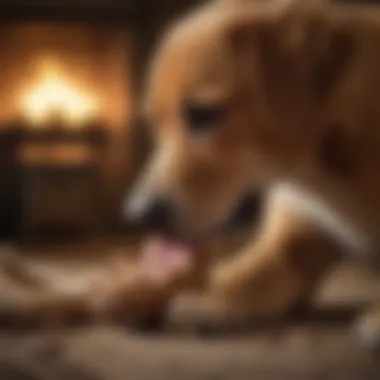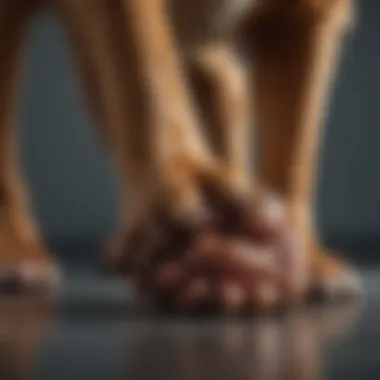Understanding Canine Behavior: Paw Licking Insights


Intro
Understanding canine behavior is crucial for dog owners who want to ensure the well-being of their pets. Paw licking is a common behavior exhibited by dogs, yet the reasons behind it often escape the notice of many. This behavior can be indicative of various underlying issues, both physical and psychological. Addressing these concerns early on can aid in preventing serious health problems and promote a better quality of life for dogs.
In this article, we will explore the significant reasons for paw licking in dogs, ranging from allergies and anxiety to boredom. By understanding the context of this behavior, dog owners can better recognize potential health risks and intervene effectively when necessary. The following sections will provide valuable insights into the causes of paw licking and recommend solutions to foster the health and happiness of canine companions.
Fascinating Facts About the Animal
Dogs are fascinating creatures, displaying a range of behaviors that reveal much about their needs and emotions.
Unique Characteristics
One of the most unique aspects of dogs is their extraordinary olfactory abilities. With up to 300 million olfactory receptors in their noses, they can detect scents at incredibly low concentrations. This ability can lead to compulsive behaviors, including paw licking, as they might be responding to irritants or allergens that are not easily detectable to humans.
Extraordinary Abilities
Another interesting fact is that dogs have a strong instinct for social interaction. This innate behavior can result in anxiety or stress when they are left alone. Such emotional responses may manifest as excessive paw licking.
Behavior and Habitat
Understanding the environment in which a dog lives can also shed light on their behaviors, including paw licking.
Natural Habitats
While domestic dogs no longer inhabit the wild, their instincts are influenced by the environments they are raised in. Dogs descended from wolves, which had to develop survival strategies. These instincts can sometimes lead to abnormal behaviors when exposed to stressors, such as sudden changes in habitat or routine.
Social Structures
Dogs are pack animals by nature. In multi-dog households, social dynamics can affect behavior. A new arrival or changes in hierarchy in the household may trigger anxiety, resulting in behaviors like paw licking. Recognizing the social structure is crucial for understanding your dog's needs.
Recent Scientific Discoveries
Recent research has expanded our knowledge about canine behavior significantly, providing insights into why dogs lick their paws.
Latest Research Findings
Studies reveal that allergies are among the leading causes of paw licking. Both food allergies and environmental allergens can lead to irritation, prompting dogs to lick their paws in an attempt to soothe themselves. Research is ongoing to better understand these allergies and their impact on canine health.
Breakthroughs in Animal Biology
Breakthroughs in veterinary medicine have also improved our capability to diagnose and treat underlying issues related to paw licking. Early identification of skin infections or irritations can transform how we approach treatment, allowing for better outcomes.
Cultural Significance
Understanding animal behavior often leads us to appreciate their significance in culture.
Animals in Folklore
Dogs have long been featured in folklore, symbolizing loyalty and protection. Their behaviors often spark curiosity and myths, which can shape our perceptions of them.
Influence on Art and Literature
In art and literature, dogs often represent companionship and the essence of loyalty. These portrayals can influence how we perceive behaviors such as paw licking, with sometimes misguided interpretations of their meanings.
By understanding the nuances of canine behavior, specifically paw licking, dog owners can provide better care and ensure their pets live healthy, happy lives. This guide serves to inform about the importance of understanding canine needs and addressing them accordingly.
Prelude to Canine Paw Licking


Paw licking in dogs is a behavior that garners attention from both pet owners and veterinarians. Recognizing the significance of this action is essential for promoting well-being and addressing underlying issues. Dogs may lick their paws for a variety of reasons—physical and psychological alike. Understanding the nuances of this behavior can greatly impact a dog's quality of life and the owner's response to it.
Understanding Dog Behavior
To comprehend why dogs lick their paws, it is crucial to have a foundational grasp of canine behavior in general. Dogs, as social creatures, communicate and express their feelings through actions. They may engage in behaviors such as sniffing, wagging their tails, or, in this case, licking. What might appear as an innocent habit can sometimes signal discomfort or anxiety.
Several factors can motivate a dog's licking behavior, ranging from instinctual traits to learned habits. For instance, a dog may lick due to boredom or as a self-soothing mechanism during stressful situations. It is vital for dog owners to be observant, as these behaviors can be indicators of broader issues needing detention.
Overview of Paw Licking
Paw licking is one of the many idiosyncrasies of dog behavior. While occasional licking is normal, persistent licking can lead to a cycle of irritation and further licking. This behavior may manifest as an attempt to relieve itching or discomfort, but it can also be a sign of a psychological issue.
Some common reasons for paw licking include:
- Allergic reactions to food or environmental factors.
- Infections that cause irritation or discomfort.
- Behavioral issues related to anxiety or stress.
Understanding the distinction between normal and excessive paw licking is essential for any dog owner.
It is vital to seek veterinary advice if paw licking becomes excessive, as it may indicate an underlying health problem or behavioral disorder.
Physical Reasons for Paw Licking
Paw licking in dogs can often signify underlying physical issues. It is essential to recognize these physical reasons as they are frequently linked to the dog's overall health. Addressing these causes promptly can prevent further complications and ensure the pet remains comfortable and happy. Identifying the specific physical triggers leading to paw licking helps dog owners take informed steps, leading to timely interventions when necessary.
Allergic Reactions
Allergic reactions are among the most common physical causes of paw licking in dogs. Dogs may react to a variety of allergens such as pollen, dust mites, certain foods, or chemicals found in cleaning products. When a dog experiences an allergic reaction, it can lead to itching and irritation. This discomfort prompts them to lick their paws in an attempt to alleviate their symptoms. Identifying the source of the allergy can be challenging but is crucial for effective treatment. Many owners may notice increased licking during certain seasons, indicating seasonal allergies. A veterinarian can prescribe antihistamines or suggest dietary changes to help manage these reactions.
Infections
Infections, particularly paw infections, can result in significant discomfort for dogs. Fungal or bacterial infections often follow if a dog licks its paws excessively, as the moisture creates an ideal environment for pathogens. Symptoms may include redness, swelling, and an abnormal smell. If a dog shows signs of persistent licking, it is essential to consult a veterinarian, who can perform tests to determine the type of infection. Treatment may involve topical or oral medications that target the specific pathogens responsible for the infection.
Injury or Pain
A dog may lick its paws due to an injury or underlying pain. This behavior reflects an instinctual attempt to soothe a hurt area. Dogs might lick cuts, scrapes, or even a splinter lodged in their paw. Additionally, arthritis or other joint issues can lead to pain that manifests as licking, particularly if a specific paw is affected. Observing a dog’s behavior can reveal if a certain area is tender or sensitive. If a dog is seen licking one paw more than others, it is important to look for signs of injury, such as swelling or bleeding. Consulting with a veterinarian for pain relief and treatment options is advisable.
Parasites
Parasites, including fleas and mites, can cause intense itchiness, leading to excessive paw licking. Fleas are particularly notorious for infesting pets, resulting in irritated skin. Likewise, mites may cause discomfort through conditions like mange. Regular grooming and preventative treatments are crucial for managing these risks. When a pet owner suspects parasites, it is vital not to delay seeking veterinary assistance. Effective treatments are available and can significantly reduce the discomfort caused by these pests.
"Early recognition of these physical signs can aid in the treatment and well-being of the pet, preventing further complications."
Behavioral and Psychological Factors
When observing canine behavior, it is crucial to understand that paw licking often stems from more than just physical causes. Behavioral and psychological factors play a significant role in this habit. Analyzing these aspects can provide valuable insights for dog owners, enabling them to address underlying issues effectively. Moreover, understanding these factors can assist in preventing escalation into more severe behavior problems. By examining behavioral triggers such as boredom, anxiety, and compulsive disorders, we can get to the root of excessive paw licking and develop tailored strategies for intervention and management.
Boredom and Anxiety
Boredom is a prevalent issue among dogs, especially in a home environment where they may be left alone for extended periods. Dogs, like humans, need mental stimulation and physical activity. A lack of engagement can lead to destructive behaviors, including excessive licking of the paws. When dogs chew or lick their paws, they might be trying to entertain themselves or release pent-up energy.
Anxiety is another critical factor associated with paw licking. Dogs may lick their paws in response to various anxiety triggers, including separation from their owners, loud noises, or changes in their environment. This compulsive behavior can be a sign that a dog is distressed and seeks comfort through self-soothing. Therefore, recognizing the difference between harmless licking and that which is driven by anxiety is essential.
Compulsive Disorders
Compulsive disorders in dogs can manifest in various forms, and paw licking is one of the more common behaviors associated with these conditions. When a dog engages in repetitive licking, it can become a compulsive behavior that is hard to break. This can be due to various factors, including stress, genetic predisposition, or an environment that lacks enrichment. It's important for dog owners to be aware of these signs and seek appropriate strategies to address compulsive behaviors. Early intervention can prevent the behavior from worsening and help return the dog to a healthier state of mind.
Self-Soothing Mechanisms
Dogs, like people, have their ways to cope with stress or discomfort. Paw licking can serve as a self-soothing mechanism for dogs experiencing stress. This is particularly evident in dogs who have experienced trauma or have a history of anxiety. By licking their paws, they may temporarily alleviate their symptoms or make themselves feel more secure. Understanding this behavior is vital for dog owners who want to provide a supportive environment. Owners may need to implement changes to their dogs’ routines or environments to foster a sense of security and comfort.


Identifying the behavioral and psychological reasons for paw licking is fundamental for ensuring a dog’s health and well-being.
Seasonal Effects on Paw Licking Behavior
Understanding the seasonal effects on paw licking behavior in dogs is crucial for pet owners. Changes in seasons influence a dog's environment, which in turn affects their physical and mental state. Recognizing these patterns helps in identifying if the licking behavior is typical or a cause for concern. During certain weather conditions, dogs may exhibit increased paw licking due to various factors.
Changes in Weather
Weather fluctuations can lead to significant changes in a dog's activity levels and habits. For example, during spring and summer, dogs often spend more time outdoors, leading to higher exposure to allergens such as pollen or grass. This increased exposure can result in allergic reactions manifesting as paw licking.
Conversely, in colder months, dogs may experience dry skin or irritations from salt used on roads and pavements. The need to soothe their paws may drive them to lick more frequently, inviting the possibility of secondary infections, if not addressed properly. Observing how your dog reacts to various weather conditions provides insight into whether their licking is a benign behavior or something needing attention.
Environmental Factors
The environment plays a critical role in influencing paw licking habits. A dog living in a predominantly dry climate may face more challenges, such as cracked pads or skin irritations, whereas a dog in a humid setting might deal with fungal infections more commonly. Being aware of these factors is essential for maintaining their paw health.
In addition, seasonal activities also affect paw licking behavior. For instance, during autumn, dogs may encounter a plethora of leaves, insects, and various debris on their paws, potentially leading to localized irritations. Recognizing these seasonal transitions allows owners to adapt their care routines, ensuring they are proactive in managing potential paw issues during specific times of the year.
"Understanding the impact of seasonal changes is vital for maintaining your dog's well-being."
In summary, paying attention to how changes in weather and environmental factors influence paw licking provides valuable insights into a dog's health. It can serve as an early warning system for discerning pet owners, guiding them on when to consult a veterinarian and ensuring their furry companions are comfortable throughout the year.
When Paw Licking Is Concerning
Paw licking can often be an innocuous behavior in dogs. However, when it becomes excessive or occurs with other unusual signs, it’s essential to take notice. Understanding when paw licking is concerning can help dog owners intervene early, potentially averting more severe health issues. This section outlines the criteria for when paw licking should raise alarms and the benefits of addressing the behavior proactively.
Frequent paw licking may indicate underlying problems. When a dog licks its paws habitually, it can lead to skin irritation, infections, or further worsening of any initial issues. Recognizing these signs not only helps address the immediate concern but also promotes the overall well-being of the pet. Observing and interpreting this behavior accurately is vital for responsible pet ownership.
Identifying Abnormal Licking Patterns
Detecting abnormal licking patterns is crucial in understanding whether your dog’s behavior warrants concern. Normal licking may involve occasional grooming, especially after playtime or walks. In contrast, signs of abnormal paw licking can include:
- Increased frequency: If your dog licks its paws more than usual, it might signal discomfort or irritation.
- Specificity: Focusing on one paw or a particular area can indicate localized issues such as allergies, infections, or injuries.
- Accompanying behaviors: If the licking is paired with shaking of the head, scratching, or whimpering, it is an indication of distress.
Tracking the duration and context of the licking will help distinguish between benign and concerning behavior. If the licking continues beyond a few days or is linked with other abnormal signs, consultation with a veterinarian is advisable.
Signs of Underlying Health Issues
Certain health issues manifest through excessive paw licking, warranting the attention of a veterinarian. Here are common indications that the behavior may stem from health problems:
- Persistent redness or swelling: These signs may indicate allergies or infections that need prompt care.
- Foul odor: A bad smell from the paws can signify a bacterial or fungal infection.
- Discharge: Any discharge from the paws or nails can hint at an infectious process.
Both physical and psychological themes can play a role in this behavior. Conditions like allergies from environmental factors or food can lead to significant discomfort, prompting dogs to lick their paws more frequently. On the psychological side, stress or anxiety can result in compulsive behaviors, including paw licking.
"Recognizing abnormal licking patterns and potential health issues early means better outcomes for our canine companions."
In summary, being vigilant about paw licking behavior can yield insights into your dog's specific health needs. By identifying abnormal licking patterns and recognizing signs of underlying health issues, pet owners can ensure their dogs receive the appropriate care and support.
Veterinary Insights on Paw Licking
Understanding the reasons behind canine paw licking is essential for dog owners and veterinarians alike. This behavior can often be a sign of underlying health issues or emotional distress. Veterinary insights provide crucial knowledge that helps in identifying when paw licking goes beyond normal grooming behavior. Engaging veterinarians in discussions about paw licking can illuminate various aspects, including medical conditions, behavioral issues, and potential treatments.
Veterinarians play a key role in diagnosing the pathological reasons for excessive paw licking. They can assess whether the root cause lies in physical ailments or if it is driven by psychological factors. By consulting a veterinary professional, dog owners can ensure they are addressing the correct issues, promoting better health and well-being for their pets. Such consultations can lead to significant improvements in a dog’s quality of life.
Consultation with a Veterinarian
When noticing frequent or excessive paw licking, the first step is to consult a veterinarian. A professional assessment is vital because it allows for a proper diagnosis of the underlying causes. Vets can provide tailored advice and solutions based on the specific needs of the dog.
During a consultation, the veterinarian will typically ask several questions, including:


- Duration: How long has the licking been occurring?
- Frequency: How often does it happen?
- Patterns: Is it specific to certain times or situations?
- Environment: Are there noticeable changes in the dog's surroundings or routine?
This comprehensive approach helps in determining if the licking is due to allergies, infections, or behavioral problems.
Moreover, veterinary consultations often include physical examinations. This is critical as it can reveal injuries, irritations, or signs of disease that may not be apparent to the owner. Such steps are essential not only for treatment but also for preventing further complications that can arise if the underlying issue goes untreated.
Diagnostic Tests and Treatments
After the initial consultation, the veterinarian may recommend specific diagnostic tests to gain more insight into the dog's health. Common tests that can be used include:
- Skin scrapings to check for parasites or infections.
- Allergy testing to identify potential allergens in the dog's environment or diet.
- Blood tests to assess overall health and the presence of underlying medical issues.
Once the diagnosis is established, treatment options can vary significantly. For example:
- If allergies are diagnosed, dietary changes or antihistamines might be suggested.
- Infections could require antibiotics or antifungal medications.
- Behavioral issues may be addressed with training techniques or anxiety-reducing strategies.
These measures highlight the importance of seeking veterinary insights. Being proactive in addressing paw licking can prevent serious health complications in the future, contributing to the dog’s overall happiness and well-being. Understanding the diagnostics and treatments available ensures that responsible pet ownership leads to a healthier life for canine companions.
Preventive Measures and Care
In understanding the behaviors associated with canine paw licking, it is essential to consider preventive measures and care. This section emphasizes strategies that can help maintain your dog's health and prevent the development of chronic conditions that may lead to excessive licking. By being proactive, owners can enhance their pets' quality of life and avoid complications associated with underlying issues.
Regular Grooming Practices
Regular grooming plays a crucial role in preventing paw licking. Keeping your dog's paws clean and well-groomed can significantly limit allergens and irritants that may trigger an allergic response. Here are some critical grooming practices:
- Regular Inspection: Check your dog’s paws frequently for signs of redness, swelling, or foreign objects lodged between the toes.
- Bathing: Bathe your dog using gentle shampoos to help remove dirt and allergens. Ensure that the paws are washed thoroughly.
- Nail Trimming: Trimming nails keeps paws in good shape and prevents pain that might lead to licking.
- Moisturizing: Applying paw balm can prevent cracking and maintain healthy pads, especially in harsh weather conditions.
Consistency in grooming not only helps avoid irritation but also strengthens the bond between you and your dog. A well-groomed pet is generally healthier and may exhibit less anxiety, contributing to lower paw licking behavior.
Environmental Enrichment and Stimulation
Providing environmental enrichment is another effective preventive measure. Dogs require mental and physical stimulation to thrive. Lack of engagement can lead to boredom and anxiety, which are common triggers for compulsive behaviors, including paw licking. Consider the following strategies to enhance your dog’s environment:
- Interactive Toys: Use toys that challenge your dog mentally, such as puzzle feeders or treat-dispensing toys. This can keep your dog occupied and reduce boredom.
- Exercise: Regular walks and playtime encourage physical activity, reducing anxiety levels and promoting overall well-being. Engage in activities that you can enjoy together, like fetch or agility training.
- Socialization: Creating opportunities for your dog to interact with other dogs can also be beneficial. This not only fulfills social needs but can also tire them out mentally and physically.
- Training: Invest time in positive reinforcement training. Teaching new commands or tricks can divert their attention from paw licking and improve bonding.
Incorporating these measures can create a stimulating environment that effectively reduces unnecessary paw licking. Not only does this lead to better health outcomes for your pet, but it also enhances their overall happiness and reduces stress.
A well-rounded approach to preventive care can significantly minimize the likelihood of your dog developing behaviors such as excessive paw licking. Regular grooming and environmental enrichment are fundamental components of effective dog ownership.
Closure
In this article, we have thoroughly examined the multifaceted reasons behind the behavior of paw licking in dogs. Understanding why dogs engage in this action is essential for pet owners, veterinarians, and those invested in animal behavior. Paw licking can originate from various sources including physical, behavioral, and environmental factors. Each of these causes influences the well-being of the dog and requires different approaches for management.
Key Considerations for Dog Owners
Recognizing the implications of excessive paw licking cannot be overstated. This behavior might indicate underlying health problems, such as allergies or infections, which could worsen if not addressed timely. Pet owners must be vigilant in observing their dogs. Changes in licking behavior can signal a shift in health status that warrants professional evaluation.
Additionally, understanding the role of mental well-being is crucial. Stress and boredom can lead to compulsive licking, indicating a need for more enrichment in the dog's environment. Providing appropriate stimulation can effectively mitigate these behavioral issues.
Here's a summary of the main benefits of understanding paw licking:
- Early Detection of Health Issues: Recognizing unusual licking patterns helps in timely consultation with a veterinarian.
- Enhanced Knowledge: Understanding behavioral demands allows owners to provide better care and address needs effectively.
- Promoting Overall Happiness: A well-informed pet owner can create an environment that supports a dog’s emotional and physical health.
Importance of Citing Reliable Sources
- Accuracy: Citing scientifically backed materials reduces the spread of misinformation. As pet owners seek to understand their dog's behavior, accurate information can lead to appropriate interventions.
- Evidence-Based Practice: For veterinarians and behaviorists, references help in establishing evidence-based practices. It strengthens the recommendations made to clients.
- Cross-Verification: Readers can explore the cited sources for broader understanding and further exploration of the topic, allowing them to cross-verify facts or discover new insights.
"A well-researched article enhances credibility and educates the reader effectively."
Types of References
- Academic Journals: Journals such as the Journal of Veterinary Behavior provide high-quality studies on canine behaviors, including paw licking.
- Veterinary Manuals and Textbooks: Resources like the Merck Veterinary Manual are valuable for understanding health implications behind behaviors.
- Online Resources: Reputable websites, such as those governed by veterinary associations, can offer insights and updates in the field.
In summary, utilizing well-chosen references is not simply an academic exercise; it plays a crucial role in shaping how information about canine behavior is disseminated. Dog owners and professionals benefit from a robust body of literature that enhances both understanding and effective response to behaviors like paw licking.







